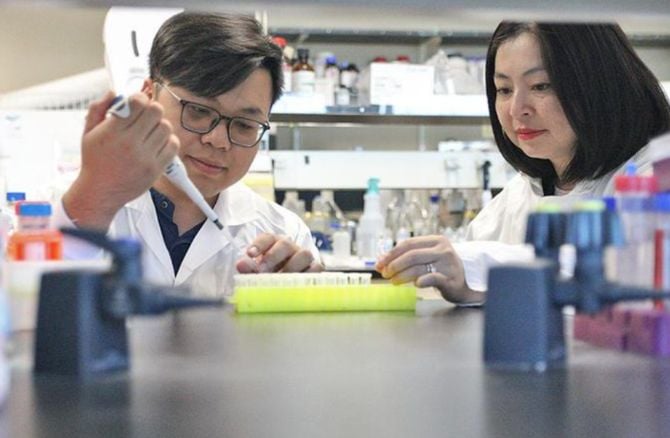
PhD student Tuan-Anh Nguyen (left) and PhD student Thu-Thuy Dang examine plant samples in the lab. Photo: UBC Okanagan
Although known for a long time, the process by which this molecule forms in nature remains a mystery. In 2023, Dr. Thu-Thuy Dang's research group at the Irving K. Barber Faculty of Science (UBC Okanagan, Canada) discovered the first plant enzyme that can twist a molecule into a helix.
Building on that breakthrough, PhD student Tuan-Anh Nguyen led the effort to identify a pair of enzymes—one that establishes the 3D configuration of the molecules and one that twists it into mitraphylline.
Dr. Dang likened: "This discovery is like finding the missing links in an assembly line. It helps answer the long-standing question of how nature creates these complex molecules, and opens the way to simulate that process in the laboratory."
Mitraphylline naturally occurs in very small amounts in several tropical plants of the coffee family such as Mitragyna (kratom) and Uncaria (cat's claw), making large-scale extraction or synthesis difficult and expensive.
By identifying the enzymes that build and shape mitraphylline, the researchers now have a roadmap for producing mitraphylline and related compounds in a sustainable way.
"This discovery opens up a green chemistry approach to creating compounds with high pharmaceutical value," said PhD student Nguyen.
The work is a collaboration between Dr. Dang's team at UBC Okanagan and Dr. Satya Nadakuduti's team at the University of Florida (USA), with support from the Natural Sciences and Engineering Research Council of Canada (NSERC), the Canada Foundation for Innovation, the BC Michael Smith Health Research Scholars Program and the National Institute of Food and Agriculture of the US Department of Agriculture.
Source: https://doanhnghiepvn.vn/cong-nghe/hai-nha-khoa-hoc-goc-viet-phat-hien-bi-an-hop-chat-chong-ung-thu-trong-tu-nhien/20251011101906892





![[Photo] Discover unique experiences at the first World Cultural Festival](https://vphoto.vietnam.vn/thumb/1200x675/vietnam/resource/IMAGE/2025/10/11/1760198064937_le-hoi-van-hoa-4199-3623-jpg.webp)






























![[Photo] General Secretary attends the parade to celebrate the 80th anniversary of the founding of the Korean Workers' Party](https://vphoto.vietnam.vn/thumb/1200x675/vietnam/resource/IMAGE/2025/10/11/1760150039564_vna-potal-tong-bi-thu-du-le-duyet-binh-ky-niem-80-nam-thanh-lap-dang-lao-dong-trieu-tien-8331994-jpg.webp)






































































Comment (0)